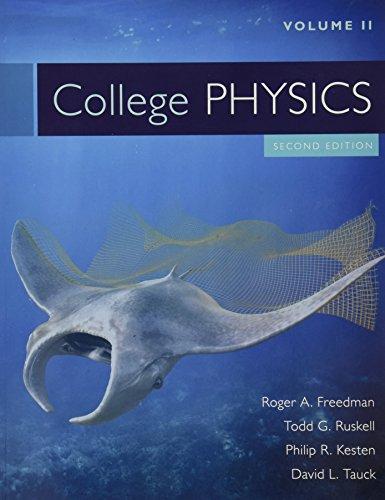
(a)
The force
Answer to Problem 50QAP
The force
Explanation of Solution
Given:

Formula used:
Newton's first law; In equilibrium
Calculation:
Considering the equilibrium of forces in + x direction
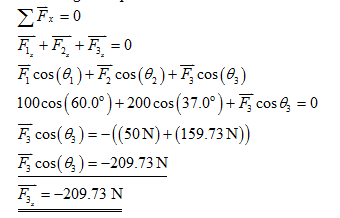
Considering the equilibrium of forces in + y direction (perpendicular to x direction)
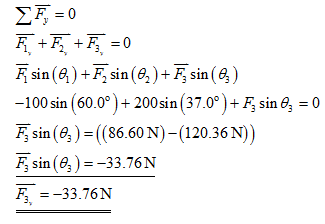
Conclusion:
Thus, component of force
(b)
Redraw the diagram with force
Answer to Problem 50QAP

Explanation of Solution
Given:
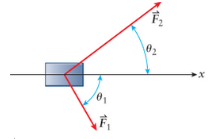
Formula used:
Newton's first law ; In equilibrium
Calculation:
Considering the equilibrium of forces in x direction,
Considering the equilibrium of forces in y direction (perpendicular to x direction),
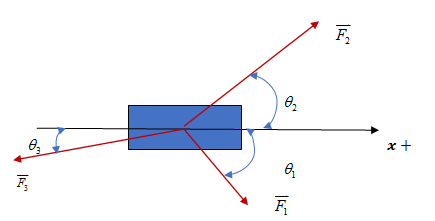
Conclusion:
Thus, the angle subtended by force
(c)
Direction of acceleration of the box
Answer to Problem 50QAP
The direction of acceleration relative to positive direction of x is
Explanation of Solution
Given:

Formula used:
Newton's second law ;
Calculation:
Considering forces in + x direction;
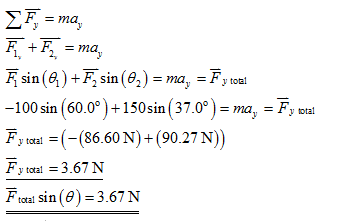
Considering the equilibrium of forces in + y direction (perpendicular to x direction);
Therefor the direction of the force
Acceleration is in the direction of the force. Therefor the direction of acceleration relative to positive direction of x is
Conclusion:
Thus, the direction of acceleration relative to positive direction of x is
(d)
Mass of the box
Answer to Problem 50QAP
Mass of the box is
Explanation of Solution
Given:
Acceleration of the box= 10 ms-2
Formula used:
Newton's second law ;
Calculation:

Conclusion:
Thus, mass of the box is
Want to see more full solutions like this?
Chapter 4 Solutions
College Physics Volume 2
- Two coplanar forces F1 and F2 are acting on an object. F1 has a magnitude of 10N directed at an angle 45 degrees to the positive x axis. F2 has a magnitude of 15 N directed at an angle 120 degrees to the positive x axis. What is the magnitude and direction of the resultant force ?arrow_forwarda person of mass 65 kg is ascending on an escalator at a constant velocity of 2.5 m/s [22° above the horizontal]. The magnitude of the net force acting on the person is ?arrow_forward2-5M Determine the magnitude ,sense ,and direction of the resultant of the three forces acting at the top of the pole in Figure 2-14Marrow_forward
- Two masses of 1.25 kg each, connected by a string, slide down a ramp making an angle of 39° with the horizontal. The coefficient of kinetic friction between m1 and the ramp is 0.29. The coefficient of kinetic friction between m2 and the ramp is 0.19. Find the magnitude of the acceleration of the masses. What is the tension in the string?arrow_forwardTwo crates, A and B, sit side by side on a frictionless horizontal surface. The crates havemasses Ma and Mb. A horizontal force F is applied to crate A and the two crates move offto the right. (a) Draw clearly labelled FBD for Crate A and Crate B. (b) If the magnitudeof force F is less than the total weight of the two crates, will it cause the crates to move?Why or why not?arrow_forwardThere are two forces on the 2.00 kg box in the overhead view of but only one is shown. For F1 = 20.0N,a =12.0 m/s2and θ= 30.0 degree find the second force (a) in unit-vector notation and as (b) a magnitude and (c) an angle relative to the positive direction of the x axis.arrow_forward
- For the woman being pulled forward on the toboggan in Figure 4.33, is the magnitude of the normal force exerted by the ground on the toboggan (a) equal to the total weight of the woman plus the toboggan, (b) greater than the total weight, (c) less than the total weight, or (d) possibly greater than or less than the total weight, depending on the size of the weight relative to the tension in the rope?arrow_forwardThe helicopter view in Fig. P3.15 shows two people pulling on a stubborn mule. The person on the right pulls with a force F1 of magnitude 120 X and direction of 1 = 60.0. The person on the left pulls with a force F2 of magnitude 80.0 N and direction of 2 = 75.0. Find (a) the single force that is equivalent to the two forces shown and (b) the force that a third person would have to exert on the mule to make the resultant force equal to zero. The forces are measured in units of newtons (symbolized N). Figure P3.15arrow_forwardA car is stuck in the mud. A tow truck pulls on the car with the arrangement shown in Fig. P4.32. The tow cable is under a tension of 2 500 N and pulls downward and to the left on the pin at its upper end. The light pin is held in equilibrium by forces exerted by the two bars A and B. Each bar is a strut; that is, each is a bar whose weight is small compared to the forces it exerts and which exerts forces only through hinge pins at its ends. Each strut exerts a force directed parallel to its length. Determine the force of tension or compression in each strut. Proceed as follows. Make a guess as to which way (pushing or pulling) each force acts on the top pin. Draw a free-body diagram of the pin. Use the condition for equilibrium of the pin to translate the free-body diagram into equations. From the equations calculate the forces exerted by struts A and B. If you obtain a positive answer, you correctly guessed the direction of the force. A negative answer means that the direction should be reversed, but the absolute value correctly gives the magnitude of the force. If a strut pulls on a pin, it is in tension. If it pushes, the strut is in compression. Identify whether each strut is in tension or in compression.arrow_forward
- The coefficient of static friction between the 3.00-kg crate and the 35.0 incline of Figure P4.31 is 0.300. What minimum force F must be applied to the crate perpendicular to the incline to prevent the crate from sliding down the incline? Figure P4.31arrow_forwardA force F1, of magnitude 6.00 units acts on an object at the origin in a direction = 30.0 above the positive x-axis (Fig. P3.8). A second force F2 of magnitude 5.00 units acts on the object in the direction of the positive y-axis. Find graphically the magnitude and direction of the resultant force F1 + F2?. Figure P3.8arrow_forwardThe forces F1, F2, F3, . . ., Fn acting on an object are in equilibrium if the resultant force is the zero vector:F1 + F2 + F3 +. . . + Fn = 0.The given forces are acting on an object.a. Find the resultant force.b. What additional force is required for the given forces to be in equilibrium?F1 = -2i + 3j, F2 = i - j, F3 = 5i - 12jarrow_forward
 Physics for Scientists and EngineersPhysicsISBN:9781337553278Author:Raymond A. Serway, John W. JewettPublisher:Cengage Learning
Physics for Scientists and EngineersPhysicsISBN:9781337553278Author:Raymond A. Serway, John W. JewettPublisher:Cengage Learning Physics for Scientists and Engineers with Modern ...PhysicsISBN:9781337553292Author:Raymond A. Serway, John W. JewettPublisher:Cengage Learning
Physics for Scientists and Engineers with Modern ...PhysicsISBN:9781337553292Author:Raymond A. Serway, John W. JewettPublisher:Cengage Learning Principles of Physics: A Calculus-Based TextPhysicsISBN:9781133104261Author:Raymond A. Serway, John W. JewettPublisher:Cengage Learning
Principles of Physics: A Calculus-Based TextPhysicsISBN:9781133104261Author:Raymond A. Serway, John W. JewettPublisher:Cengage Learning College PhysicsPhysicsISBN:9781285737027Author:Raymond A. Serway, Chris VuillePublisher:Cengage Learning
College PhysicsPhysicsISBN:9781285737027Author:Raymond A. Serway, Chris VuillePublisher:Cengage Learning College PhysicsPhysicsISBN:9781305952300Author:Raymond A. Serway, Chris VuillePublisher:Cengage Learning
College PhysicsPhysicsISBN:9781305952300Author:Raymond A. Serway, Chris VuillePublisher:Cengage Learning Glencoe Physics: Principles and Problems, Student...PhysicsISBN:9780078807213Author:Paul W. ZitzewitzPublisher:Glencoe/McGraw-Hill
Glencoe Physics: Principles and Problems, Student...PhysicsISBN:9780078807213Author:Paul W. ZitzewitzPublisher:Glencoe/McGraw-Hill





